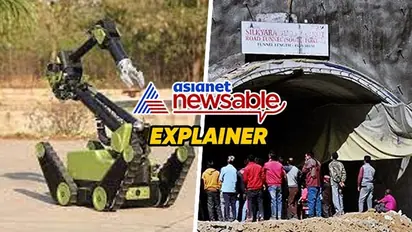Uttarakhand tunnel tragedy: How DRDO's ROVs Daksh Mini and Daksh Scout can aid rescue mission

Synopsis
The article discusses the deployment of DRDO's advanced robotic systems, Daksh Mini and Daksh Scout, in the challenging rescue operation for 41 trapped workers in a tunnel in Uttarakhand, highlighting their versatile capabilities and the ongoing efforts to overcome difficult conditions.
In a bid to accelerate the rescue operation for 41 workers trapped in a tunnel in Uttarakhand, the Defence Research and Development Organisation (DRDO) has dispatched two remotely operated vehicles (ROVs). The rescue effort, which has been ongoing for 11 days, faces formidable challenges due to the difficult conditions at the site. The DRDO responded to the request from the rescue teams at the Uttarkashi location, where a landslide on Sunday obstructed the exit of the trapped workers. Hindered by the challenging topography and soil conditions, the rescue operations within the tunnel have progressed slowly.
DRDO has been at the forefront of technological innovation, consistently working towards enhancing the country's defence capabilities. One of its notable achievements is the development of the Daksh Mini, a cutting-edge robotic system designed to address various challenges faced by defense and security forces.
Daksh Mini: Specialized for Confined Spaces
One of the deployed ROVs, Daksh Mini, is aptly named for its compact size, making it highly portable and easy to deploy in diverse terrains and scenarios. Its compact design allows for swift and discreet movement, enabling it to navigate through confined spaces, a crucial capability in tactical operations. The Daksh Mini is operated remotely, minimizing the risk to human life in high-risk situations. Equipped with advanced communication systems, operators can control the robot from a safe distance, ensuring precise maneuvering in sensitive environments such as bomb disposal or surveillance missions.
One of the key strengths of the Daksh Mini lies in its versatility. It is designed for a range of applications, including explosive ordnance disposal (EOD), surveillance, reconnaissance, and even handling hazardous materials. Its adaptability makes it an invaluable asset in dynamic and unpredictable situations.
With a two-hour operating time on a single charge and a remote range of approximately 200 meters, Daksh Mini is equipped with a manipulator arm capable of lifting loads up to 20 kg. Additionally, it features high-resolution cameras to enhance the controller's ability to navigate the vehicle effectively.
Daksh Mini is equipped with state-of-the-art sensors that provide real-time data to operators. These sensors include cameras, thermal imaging, and other environmental sensors, enhancing the robot's situational awareness. This capability is crucial for successful execution in missions that involve identification and analysis of potential threats.
Built to withstand challenging environments, Daksh Mini boasts a robust construction that allows it to operate in adverse weather conditions and rough terrains. This durability ensures that the robot can perform consistently in various scenarios, providing reliable support to defense and security personnel.
Despite its advanced capabilities, the Daksh Mini features a user-friendly interface that simplifies the operation for military and security personnel. Intuitive controls and a straightforward interface enable operators to quickly learn and efficiently use the robot in the field.
The Daksh Mini is designed to seamlessly integrate with other defence systems, enhancing overall operational efficiency. Its compatibility with existing infrastructure and technology makes it a valuable asset for defence forces seeking to modernize their capabilities.
Daksh Scout: Versatile Surveillance Rover
The second ROV, Daksh Scout, serves as a surveillance rover designed for various terrains, including the ability to climb stairs and descend inclined surfaces. Offering a 360-degree view through its cameras, Daksh Scout provides real-time visuals to the controller. Notably, the rover is capable of continuous operation and possesses advanced capabilities, including bomb defusal.
The Daksh Scout's design prioritizes stealth and unobtrusive operation, allowing it to navigate through diverse terrains and environments without drawing attention. This capability is essential for covert reconnaissance missions, where minimizing the risk of detection is paramount.
The Daksh Scout is equipped with autonomous navigation capabilities, reducing the dependency on manual control in certain scenarios. This autonomy allows the robot to adapt to changing environments, make informed decisions, and navigate obstacles intelligently, contributing to its effectiveness in dynamic situations.
The Daksh Scout excels in this aspect with its real-time data transmission capabilities, ensuring that operators receive timely updates and insights from the field. This feature is invaluable for making informed decisions on the go.
While the specific utilization plan for these rovers in the rescue operation remains unclear, DRDO officials express confidence in their suitability for the mission.
Extended Duration of Workers' Confinement
The 41 workers have been trapped in the under-construction tunnel since November 12. This tunnel, part of the ambitious Char Dham project by the central government, is situated between Silkyara and Dandalgaon in Uttarakhand, forming a critical part of the proposed road connecting Uttarkashi and Yamunotri. Rescuers report progress in drilling through about halfway of the debris as they work to create a passage wide enough for the workers to crawl out.
Stay updated with the Breaking News Today and Latest News from across India and around the world. Get real-time updates, in-depth analysis, and comprehensive coverage of India News, World News, Indian Defence News, Kerala News, and Karnataka News. From politics to current affairs, follow every major story as it unfolds. Get real-time updates from IMD on major cities weather forecasts, including Rain alerts, Cyclone warnings, and temperature trends. Download the Asianet News Official App from the Android Play Store and iPhone App Store for accurate and timely news updates anytime, anywhere.